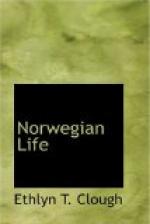It is this characteristic which has made the poet appeal so powerfully to the minds of the people. He seems to see with their eyes and feel with their hearts, and to have experienced all the vicissitudes of their own life. And yet he eminently reflects his own time, the gay, the light-hearted Gustavian era, with its classical fancies and rococo tastes. Venus and Bacchus, the Nymphs and the Dryads, Hebe and Amor are mixed up incongruously with the homely scenes of Scandinavian life. His Dutch pictures assume then a Watteau-like coloring of extraordinary effect, as fancy and contrast enhance the sharp outlines of his figures and give their vitality still greater relief. They are so lifelike and so various that the whole of the every-day life of Sweden, and more especially of Stockholm, of the eighteenth century, is unrolled before our eyes. It is said that if every other book descriptive of the period were to fail, his verses would suffice to inform us how the middle classes then lived, thought, and felt. Around the poet’s monument—his bust in bronze on a white marble column—there gather, on the anniversary of his birth, the crowds who love him and love his song. Every heart beats high as the Bellman choirs burst forth in turn into the well-known melodies, composed or adapted by the poet himself to his words, and sung by him to the accompaniment of his lute. And song alternates with enthusiastic orations, addressed to the crowd by improvised orators, teeming with quotations of well-known lines. It is an orgy of Bellman’s verse, such as the Stockholmer specially delights in. Bellman’s songs generally form a sequence, a continuous chain of lyrical romance. His Fredman’s Epistles are a sort of epic cycle of lyrics. This is a form often adopted by Swedish poets. We find it in Tegner’s Frithiof’s Saga, in Runeberg’s Sayings of Sergeant Stal, and in the works of other poets. It is a question, however, whether even by these Master Singers, in their more elaborate conceptions and genial flights of poetry, Bellman has ever been surpassed. In lyric power and vivid realism, his popular ditties are unrivaled.
The next to incarnate the genius of the Scandinavian race was Tegner. His love of brave deeds and reckless adventure and his exaltation of the man of action above the man of thought are typical. His heroes, fair-haired and blue-eyed, stalwart and vigorous, relying on strength and longing for adventure, tender-hearted and contemplative when not aroused to violent action and bent on deeds of valor, personify the national ideal. His whole vision of life is Scandinavian, bright and vivid, with a tinge of melancholy. Tegner was, with Geijer and Ling, the first to adopt national subjects, to use the Scandinavian myths and folk-lore in their poetry, in opposition to the classical themes and the Hellenic mythology, until then exclusively in vogue in the poetical field.




